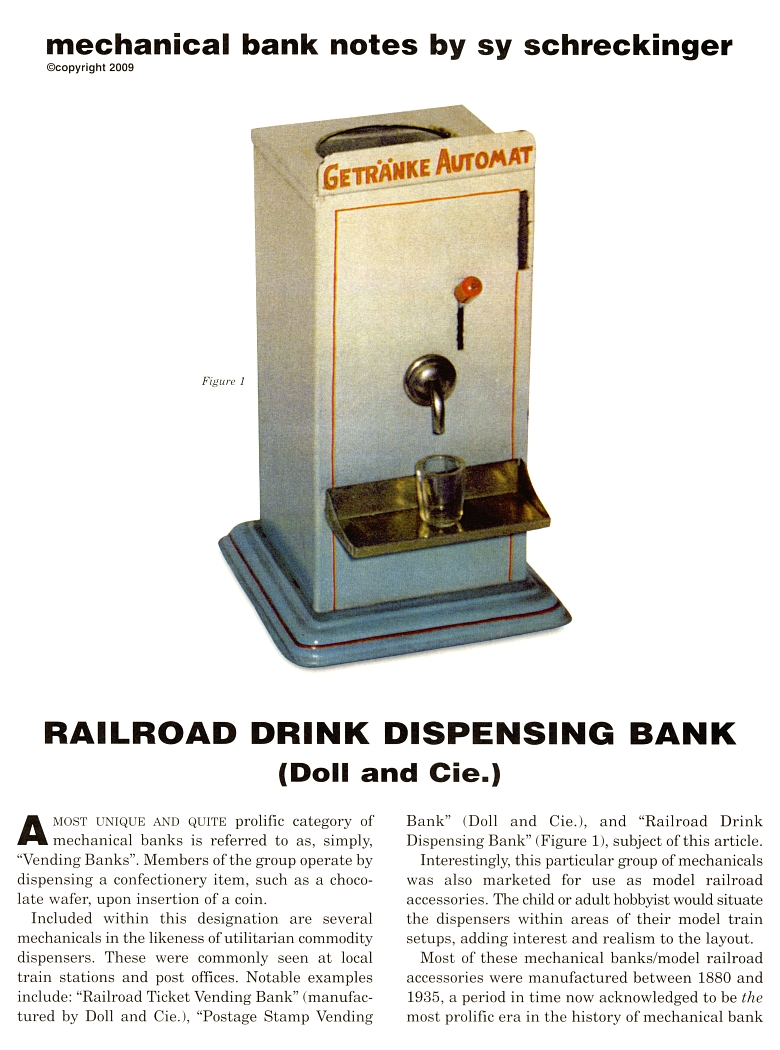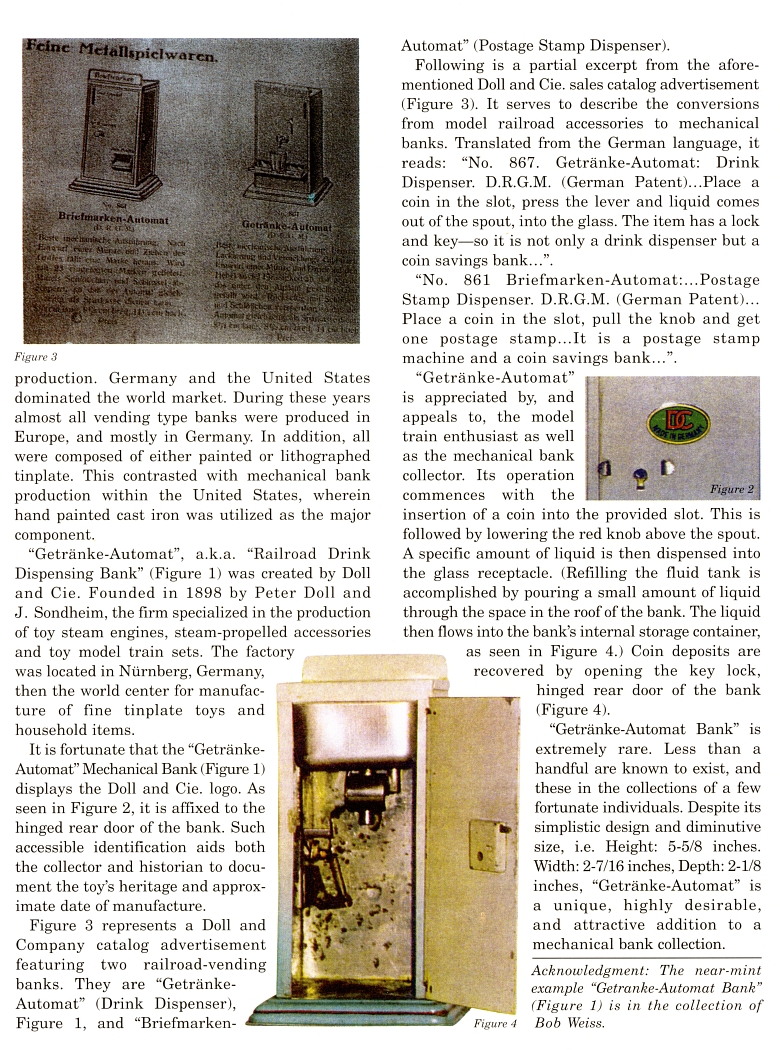|
Railroad Drink Dispensing Bank
(Doll and Cie.)
by Sy Schreckinger – ANTIQUE TOY WORLD Magazine – April, 2009
A most unique and quite prolific category of
mechanical banks is referred to as, simply, "Vending Banks". Members of
the group operate by dispensing a confectionery item, such as a chocolate
wafer, upon insertion of a coin.
Included within this designation are several mechanicals in the
likeness of utilitarian commodity dispensers. These were commonly seen at
local train stations and post offices. Notable examples include: "Railroad
Ticket Vending Bank" (manufactured by Doll and Cie.), "Postage Stamp
Vending Bank" (Doll and Cie.), and "Railroad Drink Dispensing Bank"
(Figure 1), subject of this article.
Interestingly, this particular group of mechanicals was also marketed
for use as model railroad accessories. The child or adult hobbyist would
situate the dispensers within areas of their model train setups, adding
interest and realism to the layout.
Most of these mechanical banks/model railroad accessories were
manufactured between 1880 and 1935, a period in time now acknowledged to
be the most prolific era in the history of mechanical bank production.
Germany and the United States dominated the world market. During these
years almost all vending type banks were produced in Europe, and mostly in
Germany. In addition, all were composed of either painted or lithographed
tinplate. This contrasted with mechanical bank production within the
United States, wherein hand painted cast iron was utilized as the major
component.
"Getranke-Automat", a.k.a. "Railroad Drink Dispensing Bank" (Figure
1) was created by Doll and Cie. Founded in 1898 by Peter Doll and J.
Sondheim, the firm specialized in the production of toy steam engines,
steam-propelled accessories and toy model train sets. The factory was
located in Nurnberg, Germany, then the world center for manufacture of
fine tinplate toys and household items.
It is fortunate that the "Getranke-Automat" Mechanical Bank (Figure
1) displays the Doll and Cie. logo. As seen in Figure 2, it is affixed to
the hinged rear door of the bank. Such accessible identification aids both
the collector and historian to document the toy's heritage and approximate
date of manufacture.
Figure 3 represents a Doll and Company catalog advertisement
featuring two railroad-vending banks. They are "Getranke-Automat" (Drink
Dispenser), Figure 1, and "Briefmarken-Automat" (Postage Stamp Dispenser).
Following is a partial excerpt from the aforementioned Doll and Cie.
sales catalog advertisement (Figure 3). It serves to describe the
conversions from model railroad accessories to mechanical banks.
Translated from the German language, it reads: "No. 867. Getranke-Automat:
Drink Dispenser. D.R.G.M. (German Patent)...Place a coin in the slot,
press the lever and liquid comes out of the spout, into the glass. The
item has a lock and key — so it is not only a drink dispenser but a coin
savings bank...".
"No. 861 Briefmarken-Automat:...Postage Stamp Dispenser. D.R.G.M.
(German Patent)... Place a coin in the slot, pull the knob and get one
postage stamp...It is a postage stamp machine and a coin savings bank...".
"Getranke-Automat" is appreciated by, and appeals to, the model train
enthusiast as well as the mechanical bank collector. Its operation
commences with the insertion of a coin into the provided slot. This is
followed by lowering the red knob above the spout. A specific amount of
liquid is then dispensed into the glass receptacle. (Refilling the fluid
tank is accomplished by pouring a small amount of liquid through the space
in the roof of the bank. The liquid then flows into the bank's internal
storage container, as seen in Figure 4.) Coin deposits are recovered by
opening the key lock, hinged rear door of the bank (Figure 4).
"Getranke-Automat Bank" is extremely rare. Less than a handful are
known to exist, and these in the collections of a few fortunate
individuals. Despite its simplistic design and diminutive size, i.e.
Height: 5-5/8 inches. Width: 2-7/16 inches, Depth: 2-1/8 inches, "Getranke-Automat"
is a unique, highly desirable, and attractive addition to a mechanical
bank collection.
Acknowledgment: The near-mint example "Getranke-Automat Bank" (Figure
1) is in the collection of Bob Weiss.
|


